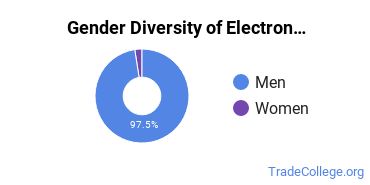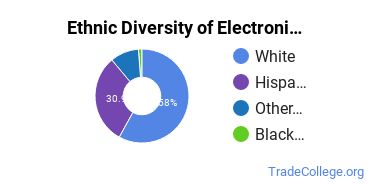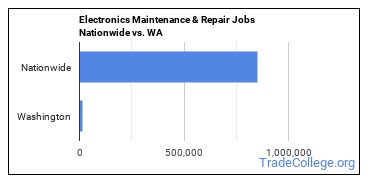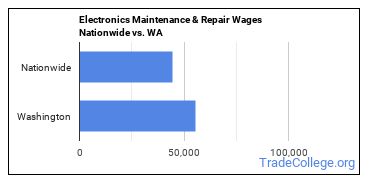Electronics Maintenance & Repair Schools in Washington
In 2021-2022, 71 students earned their Electronics Repair degrees in WA.
In this state, Electronics Maintenance & Repair is the 27th most popular major out of a total 52 majors commonly available.
Featured schools near , edit
Education Levels of Electronics Maintenance & Repair Majors in Washington
Electronics Repair majors in the state tend to have the following degree levels:
| Education Level | Number of Grads |
|---|---|
| Associate Degree | 60 |
| Award Taking 1 to 2 Years | 11 |
| Award Taking 2 to 4 Years | 11 |
Gender Distribution
In Washington, a electronics repair major is more popular with men than with women.

Racial Distribution
The racial distribution of electronics repair majors in Washington is as follows:
- Asian: 1.4%
- Black or African American: 1.4%
- Hispanic or Latino: 40.8%
- White: 49.3%
- Non-Resident Alien: 0.0%
- Other Races: 7.0%

Jobs for Electronics Maintenance & Repair Grads in Washington
16,270 people in the state and 851,880 in the nation are employed in jobs related to electronics repair.

Wages for Electronics Maintenance & Repair Jobs in Washington
In this state, electronics repair grads earn an average of $55,610. Nationwide, they make an average of $44,710.

Most Popular Electronics Maintenance & Repair Programs in WA
There are 5 colleges in Washington that offer electronics repair degrees. Learn about the most popular 5 below:
Students enjoy a student to faculty ratio of 14 to 1. Of all the teachers who work at the school, 96% are considered full time. This private institution charges an average net price of $19,067.
Students enjoy a student to faculty ratio of 15 to 1. A typical student attending Walla Walla Community College will pay a net price of $6,548. This school boasts a lower than average student loan default rate of 4.40%.
The student to faculty ratio is 19 to 1. Grads earn an average early-career salary of $44,012 after earning their degree at this institution. 42% of students are awarded financial aid at this school.
The student to faculty ratio is 16 to 1. The student loan default rate of 1.20% is a good sign that graduates can afford their loan payments. Of all the teachers who work at the school, 100% are considered full time.
65% of students are awarded financial aid at this school. Roughly six years after entering college, graduates of this school earn $33,905 a year. Students enjoy a student to faculty ratio of 14 to 1.
Electronics Maintenance & Repair Careers in WA
Some of the careers electronics repair majors go into include:
| Job Title | WA Job Growth | WA Median Salary |
|---|---|---|
| Security and Fire Alarm Systems Installers | 28% | $51,540 |
| Telecommunications Line Installers and Repairers | 14% | $64,980 |
| Installation, Maintenance, and Repair Workers | 10% | $53,740 |
| Computer, Automated Teller, and Office Machine Repairers | 9% | $38,940 |
| Electronic Home Entertainment Equipment Installers and Repairers | 8% | $38,720 |
| Electric Motor, and Power Tool Repairers | 3% | $54,760 |
| Home Appliance Repairers | 2% | $39,670 |
| Telecommunications Equipment Installers and Repairers | 2% | $67,020 |
| Industrial Equipment Electrical and Electronics Repairers | 1% | $71,740 |
| Radio, Cellular, and Tower Equipment Installers and Repairs | 0% | $71,740 |
| Radio Operators | 0% | $0 |
Related Majors in Washington
Below are some popular majors in the state that are similar to electronics repair.
| Major | Annual Graduates in WA |
|---|---|
| Vehicle Maintenance & Repair | 1,808 |
| Heating, Ventilation, Air & Cooling | 373 |
| Heavy Equipment Maintenance | 100 |
| Precision Systems Maintenance | 17 |
| 8 |
View all majors related to Electronics Maintenance & Repair
Explore Major by State
Alabama
Arkansas
Connecticut
Florida
Idaho
Iowa
Louisiana
Massachusetts
Mississippi
Nebraska
New Jersey
North Carolina
Oklahoma
Rhode Island
Tennessee
Vermont
West Virginia
View Nationwide Electronics Maintenance & Repair Report
References
More about our data sources and methodologies.
Featured Schools
 Request Info
Request Info
|
Southern New Hampshire University You have goals. Southern New Hampshire University can help you get there. Whether you need a bachelor's degree to get into a career or want a master's degree to move up in your current career, SNHU has an online program for you. Find your degree from over 200 online programs. Learn More > |

